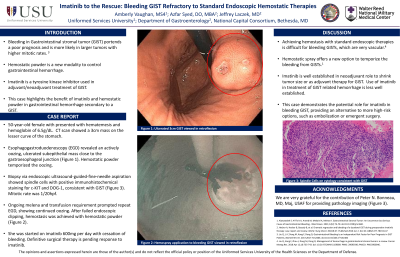Back


Poster Session B - Monday Morning
Category: GI Bleeding
B0342 - Imatinib to the Rescue: Bleeding GIST Refractory to Standard Endoscopic Hemostatic Therapies
Monday, October 24, 2022
10:00 AM – 12:00 PM ET
Location: Crown Ballroom

Has Audio

Azfar S. Syed, DO, MBA
Walter Reed National Military Medical Center
Bethesda, MD
Presenting Author(s)
Azfar S. Syed, DO, MBA1, Amberly Vaughan, BS2, John McCarthy, MD1, Jeffrey Laczek, MD1
1Walter Reed National Military Medical Center, Bethesda, MD; 2Uniformed Services University of the Health Sciences, Hebert School of Medicine, North Bethesda, MD
Introduction: Gastrointestinal stromal tumors (GISTs) are neoplasms which arise from the muscular wall of the gastrointestinal tract and can rarely be the cause of gastrointestinal bleeding. Bleeding is more common in larger tumors with higher mitotic rates, which portends a poor prognosis. Imatinib is a tyrosine kinase inhibitor well-established in the treatment of GISTs that may have a hemostatic benefit in bleeding GISTs. Hemostatic spray is a relatively new hemostatic modality that may be effective when other endoscopic options for hemostasis are ineffective. This case highlights the potential benefit of imatinib and hemostatic spray in the treatment of bleeding GISTs.
Case Description/Methods: A 50-year-old female presented with hematemesis. Her hemoglobin dropped as low as low as 6.5 g/dL and a CT scan showed a 3 cm mass on the lesser curve of the stomach. She was treated with IV pantoprazole and packed red blood cell transfusions before upper endoscopy showed an actively oozing ulcerated subepithelial mass close to the gastroesophageal junction. The oozing was temporized with hemostatic powder. The patient underwent endoscopic ultrasound-guided-fine-needle aspiration (EUS/FNA) of the mass with cytology showing spindle cells and positive immunohistochemical staining for c-KIT and DOG-1, consistent with a GIST. The mitotic rate was 1 per 20 high power fields. During hospitalization, melena and an ongoing transfusion requirement prompted a repeat upper endoscopy, which showed continued oozing from the lesion. Hemostasis with endoscopic clipping was unsuccessful, but was achieved by coating the lesion with hemostatic powder. The patient was started on imatinib 600 mg per day with no recurrence of gastrointestinal bleeding.
Discussion: Achieving hemostasis with standard endoscopic therapies is difficult for bleeding GISTs, which are very vascular tumors. Hemostatic spray offers a new option to temporize the bleeding from GISTs and we encourage endoscopists to become familiar with this treatment modality. The role of imatinib is well established in the adjuvant treatment of high-risk GISTs and the neoadjuvant treatment of GISTs when resection carries significant morbidity. Imatinib therapy of hemorrhage related to GISTs, while previously described, is less well established. This case demonstrates the potential role for imatinib in bleeding GIST, providing an alternative to more high-risk options, such as embolization or emergent surgery.
Disclosures:
Azfar S. Syed, DO, MBA1, Amberly Vaughan, BS2, John McCarthy, MD1, Jeffrey Laczek, MD1. B0342 - Imatinib to the Rescue: Bleeding GIST Refractory to Standard Endoscopic Hemostatic Therapies, ACG 2022 Annual Scientific Meeting Abstracts. Charlotte, NC: American College of Gastroenterology.
1Walter Reed National Military Medical Center, Bethesda, MD; 2Uniformed Services University of the Health Sciences, Hebert School of Medicine, North Bethesda, MD
Introduction: Gastrointestinal stromal tumors (GISTs) are neoplasms which arise from the muscular wall of the gastrointestinal tract and can rarely be the cause of gastrointestinal bleeding. Bleeding is more common in larger tumors with higher mitotic rates, which portends a poor prognosis. Imatinib is a tyrosine kinase inhibitor well-established in the treatment of GISTs that may have a hemostatic benefit in bleeding GISTs. Hemostatic spray is a relatively new hemostatic modality that may be effective when other endoscopic options for hemostasis are ineffective. This case highlights the potential benefit of imatinib and hemostatic spray in the treatment of bleeding GISTs.
Case Description/Methods: A 50-year-old female presented with hematemesis. Her hemoglobin dropped as low as low as 6.5 g/dL and a CT scan showed a 3 cm mass on the lesser curve of the stomach. She was treated with IV pantoprazole and packed red blood cell transfusions before upper endoscopy showed an actively oozing ulcerated subepithelial mass close to the gastroesophageal junction. The oozing was temporized with hemostatic powder. The patient underwent endoscopic ultrasound-guided-fine-needle aspiration (EUS/FNA) of the mass with cytology showing spindle cells and positive immunohistochemical staining for c-KIT and DOG-1, consistent with a GIST. The mitotic rate was 1 per 20 high power fields. During hospitalization, melena and an ongoing transfusion requirement prompted a repeat upper endoscopy, which showed continued oozing from the lesion. Hemostasis with endoscopic clipping was unsuccessful, but was achieved by coating the lesion with hemostatic powder. The patient was started on imatinib 600 mg per day with no recurrence of gastrointestinal bleeding.
Discussion: Achieving hemostasis with standard endoscopic therapies is difficult for bleeding GISTs, which are very vascular tumors. Hemostatic spray offers a new option to temporize the bleeding from GISTs and we encourage endoscopists to become familiar with this treatment modality. The role of imatinib is well established in the adjuvant treatment of high-risk GISTs and the neoadjuvant treatment of GISTs when resection carries significant morbidity. Imatinib therapy of hemorrhage related to GISTs, while previously described, is less well established. This case demonstrates the potential role for imatinib in bleeding GIST, providing an alternative to more high-risk options, such as embolization or emergent surgery.
Disclosures:
Azfar Syed indicated no relevant financial relationships.
Amberly Vaughan indicated no relevant financial relationships.
John McCarthy indicated no relevant financial relationships.
Jeffrey Laczek indicated no relevant financial relationships.
Azfar S. Syed, DO, MBA1, Amberly Vaughan, BS2, John McCarthy, MD1, Jeffrey Laczek, MD1. B0342 - Imatinib to the Rescue: Bleeding GIST Refractory to Standard Endoscopic Hemostatic Therapies, ACG 2022 Annual Scientific Meeting Abstracts. Charlotte, NC: American College of Gastroenterology.
